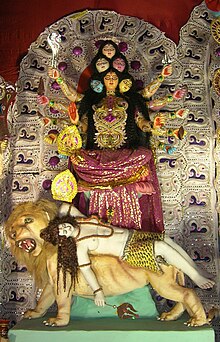Kamakhya
| Kamakhya | |
|---|---|
 |
|
| Sanskrit transliteration | Kāmākhyā |
| Affiliation | Devi |
| Mantra | kāmākhye varade devī nīla parvata vāsinī tvaṁ devī jagataṁ mātā yonimudre namostute |
| Weapon | sword, trident, discus, shield, bow, arrows, club, lotus, bell, goad, kapala, conch |
| Consort | Shiva |
| Mount | Lion |
Kamakhya (Assamese: কামাখ্যা দেৱী, Bengali: কামাখ্যা দেবী) is an important Hindu Tantric goddess of desire who evolved in the Himalayan hills. She is also identified as Kali and Maha Tripura Sundari. According to the Tantric texts (Kalika Purana, Yogini Tantra) that are the basis for her worship at the Kamakhya temple, a 16th-century temple in the Kamrup district of Assam. The earlier manifest of the goddess sanctified at the Garo hills is destroyed, although the Vatsayana priests are said to have carried away the manifest of the goddess to the Hindu kingdom in Kashmir and later sanctified in a remote hill forest in Himachal. Her name means "renowned goddess of desire," and she resides at the presently rebuilt Kamakhya Temple in 1645 C. The temple is primary amongst the 51 Shakti Peethas related to the sect that follows Sati, and remains one of the most important Shakta temples and Hindu pilgrimage sites in the world.
The origin of worship 'Shakti' at the site is associated with the legend of Sati, who was the wife of the ascetic god Shiva and daughter of the Puranic god-king Daksha. Daksha was unhappy with his daughter's choice of husband, and when he performed a grand Vedic sacrifice for all the deities, he did not invite Shiva or Sati. In a rage, Sati threw herself onto the fire, knowing that this would make the sacrifice impure. Because she was the all-powerful mother goddess, Sati left her body in that moment to be reborn as the goddess Parvati. Meanwhile, Shiva was stricken with grief and rage at the loss of his wife. He put Sati's body over his shoulder and began his tandava (dance of cosmic destruction) throughout the heavens, and vowed not to stop until the body was completely rotted away. The other Gods, afraid of their annihilation, implored Vishnu to pacify Shiva. Thus, wherever Shiva wandered while dancing, Vishnu followed. He sent his discus Sudarshana to destroy the corpse of Sati. Pieces of her body fell until Shiva was left without a body to carry. Seeing this, Shiva sat down to do Mahatapasya (great penance). Despite the similarity in name, scholars do not generally believe that this legend gave rise to the practice of sati or the voluntary giving of the wife's body on the pyre of her husband (Historically, "Jauhar" is an Islamic practice mistakenly described as Sati ).
...
Wikipedia
